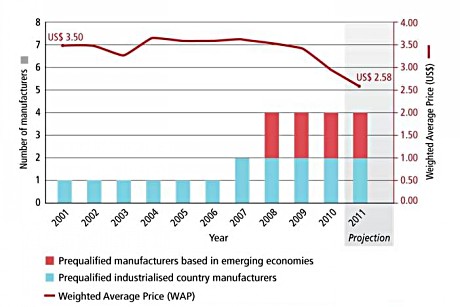Price of life-saving vaccine expected to drop significantly in 2011

Increased competition reduces vaccine price - Number of manufacturers and price decline of pentavalent vaccine. Source: UNICEF Supply Division, 2010.
Geneva, 26 November 2010 - A life-saving vaccine against five deadly diseases will now be less expensive for the world's poorest children, the GAVI Alliance announced today.
Thanks to increased demand for the "pentavalent" vaccine and a reduced price offer by an emerging market vaccine manufacturer, GAVI estimates that in 2011 the average weighted price for the vaccine will go down to US$ 2.58, compared to the current average price of US$ 2.97, and to an even higher price of US$ 3.65 in 2004. This represents a decrease of 30% over the last seven years.
The "pentavalent" vaccine
The conjugate vaccine, which protects a child against diphtheria, tetanus, pertussis, Haemophilus influenzae type b (Hib), and hepatitis B, is highly useful in low-income countries where access to health services particularly in rural and remote areas is often limited and mothers have a much harder time bringing their infants to be regularly vaccinated.
By using the pentavalent vaccine, widespread protection is achieved quickly and safely, shipping costs are lower and, with fewer syringes to dispose of, environmental impact is reduced. The number of injections for babies is also reduced.
GAVI's commitment in 2000 to fund the vaccine for low-income countries has drawn new manufacturers to the market, creating competition and ultimately leading to a drop in prices.
"By pooling the strong demand by developing countries and ensuring long-term sustainable funding, these vaccines are becoming increasingly affordable. As a result, more children can be protected against these deadly diseases," said Helen Evans, GAVI's interim CEO.
By pooling the strong demand by developing countries and ensuring long-term sustainable funding, these vaccines are becoming increasingly affordable. Helen Evans, GAVI's interim CEO |
288 million immunised, five million deaths averted
New data shows that since GAVI's inception in 2000, 288 million additional children have been immunised and over five million premature deaths prevented.
However, Helen Evans highlighted that challenges remain. Even with lower vaccine prices, GAVI needs approximately US$ 3.7 billion over the next five years to continue providing pentavalent vaccine to low-income countries, as well as new vaccines including in particular against pneumonia and diarrhoeal diseases, the two biggest killers of young children in the world.
"Immunisation provides a highly-cost-effective foundation to build strong and healthy communities and economies," said Evans. "Industry, donors and the countries themselves must continue to do all that they can to ensure that the world's vulnerable children have the same access to life-saving vaccines as their counterparts in wealthy nations."
GAVI estimates that a fully-funded programme would prevent 3.9 million future deaths by 2015 and make a significant impact on further reducing child mortality around the world.
